Welcome to your comprehensive pool maintenance guide․ Regular upkeep ensures safety, clarity, and longevity․ Learn essential tips and best practices to keep your pool pristine year-round․
Welcome to Pool Maintenance
Maintaining your pool is essential for ensuring safety, clarity, and longevity․ Regular upkeep prevents algae growth, balances chemicals, and keeps equipment functioning smoothly․ This guide provides a comprehensive approach to daily, weekly, and seasonal tasks, helping you enjoy a pristine pool year-round․ Whether you’re a novice or experienced owner, these tips and best practices will empower you to tackle challenges confidently and efficiently, ensuring your pool remains a clean and enjoyable space for everyone․
Importance of Regular Pool Maintenance
Regular pool maintenance is crucial for ensuring safety, hygiene, and longevity․ Proper upkeep prevents algae growth, balances chemicals, and maintains equipment efficiency․ Neglecting maintenance can lead to cloudy water, safety hazards, and costly repairs․ By following a consistent routine, you protect your investment and create a clean, enjoyable environment for swimming․ Regular care also extends the lifespan of your pool and its equipment, saving you time and money in the long run․ A well-maintained pool enhances your outdoor space and provides endless recreational opportunities․
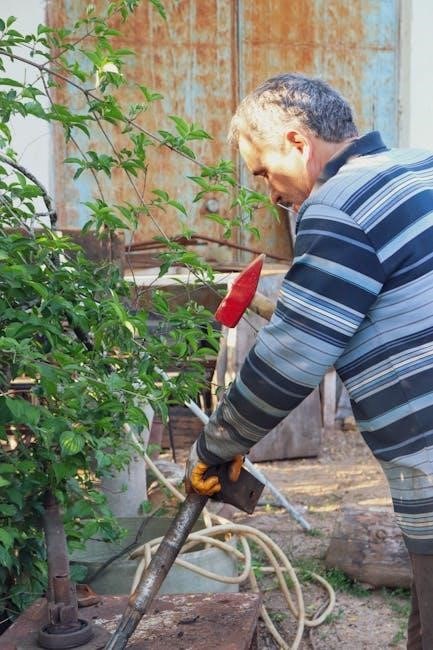
Essential Pool Maintenance Tasks
Regular pool maintenance is the backbone of keeping your pool clean and safe․ It involves daily, weekly, and monthly tasks like testing chemicals, cleaning surfaces, and equipment checks․
Daily Maintenance Tasks
Daily maintenance ensures your pool remains clean and safe․ Start by skimming the surface to remove floating debris like leaves and insects․ Check the pool water level to ensure it’s adequate for proper circulation․ Test the pH and chlorine levels briefly, though detailed testing is weekly․ Inspect the pump and filter for any blockages or damage․ Brush the walls and floor lightly to prevent algae buildup․ Lastly, empty the skimmer baskets to maintain efficient water flow․ Consistency in these tasks prevents larger issues from arising․
Weekly Maintenance Tasks
Weekly maintenance is crucial for maintaining a healthy pool․ Begin by vacuuming the pool floor and walls to remove dirt and debris that daily skimming misses․ Clean the tile line with a specialized cleaner to prevent staining․ Perform a thorough test of pH, chlorine, CYA, and alkalinity levels, adjusting as needed․ Backwash the filter according to the manufacturer’s instructions to ensure optimal performance․ Inspect the pool equipment, such as the pump and heater, for any signs of wear or damage․ Regularly brushing the pool walls and floor helps prevent algae growth; Consistency in these tasks ensures your pool stays clean and safe throughout the season․
Monthly Maintenance Tasks
Monthly maintenance ensures long-term pool health․ Shock the pool to eliminate built-up contaminants and oxidize organic matter․ Deep clean the filter by soaking it in a recommended solution to remove embedded dirt․ Inspect and lubricate pool equipment, such as O-rings and gaskets, to prevent leaks․ Check the heater for efficiency and proper function․ Balance stabilizer levels to protect chlorine from sunlight degradation․ Perform a detailed inspection of the pool and surrounding areas for any signs of damage or wear․ Monthly tasks prevent major issues and maintain optimal water quality year-round․ Regularity is key to a trouble-free pool experience․
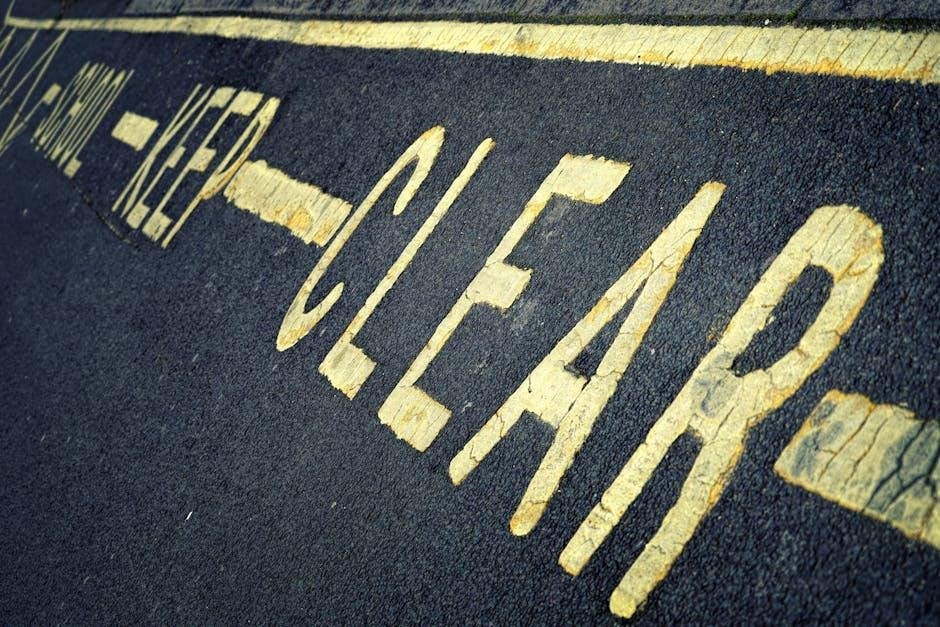
Chemical Balance and Testing
Proper chemical balance is crucial for pool safety and clarity․ Regular testing ensures pH, chlorine, and stabilizer levels are within recommended ranges to prevent damage and health risks․
Understanding pH Levels
Maintaining the correct pH level is vital for pool water safety and clarity․ The ideal pH range is between 7․2 and 7․6․ A pH level below 7․0 can cause eye irritation and corrode equipment, while levels above 7․8 reduce chlorine effectiveness․ Testing pH regularly ensures a comfortable swimming environment and optimal sanitizer performance․ Use pH test kits or digital devices for accurate readings․ Adjustments are typically made with muriatic acid or soda ash to maintain balance and prevent potential health risks․
Chlorine Levels and Adjustment
Maintaining proper chlorine levels is crucial for sanitizing pool water and preventing contaminants․ The ideal chlorine level ranges from 1 to 3 ppm (parts per million)․ Higher levels can irritate skin and eyes, while lower levels may allow bacteria and algae to grow․ Regular testing is essential to ensure safe and effective disinfection․ Adjust chlorine levels by adding stabilizers or shock treatments as needed․ Cyanuric acid (CYA) helps stabilize chlorine, especially in sunny conditions, ensuring longer-lasting protection․ Always follow manufacturer guidelines for accurate dosing and maintenance․
CYA (Cyanuric Acid) Levels
Cyanuric acid (CYA) stabilizes chlorine in pool water, preventing it from being depleted by sunlight․ The ideal CYA level for residential pools is 30-50 ppm․ Lower levels reduce chlorine’s effectiveness, while higher levels can decrease chlorine’s efficiency․ CYA is especially crucial for outdoor pools exposed to direct sunlight․ Testing CYA levels regularly ensures proper stabilization․ Unlike chlorine, CYA does not evaporate, so it typically only needs to be added once at the start of the season․ Always test and adjust CYA levels to maintain optimal pool water balance and sanitation․
Alkalinity and Its Role
Alkalinity acts as a buffer, stabilizing pH levels to prevent drastic fluctuations․ The ideal alkalinity range for pools is 80-120 ppm․ Low alkalinity can cause pH instability, leading to equipment corrosion or cloudy water, while high levels may reduce chlorine efficiency․ Testing alkalinity regularly ensures water balance and prevents potential issues․ Adjustments are typically made using acids like muriatic acid to maintain stability․ Proper alkalinity levels are crucial for swimmer comfort and long-term pool health․ Always test and adjust alkalinity before modifying pH or chlorine levels․
Stabilizers in Pool Water
Stabilizers, like cyanuric acid (CYA), protect chlorine from sunlight degradation, ensuring its effectiveness․ The ideal CYA level is 30-50 ppm for residential pools and up to 100 ppm for commercial pools․ Low CYA levels reduce chlorine’s efficiency, while excessive levels can hinder chlorine’s ability to sanitize․ Testing CYA regularly ensures optimal protection and prevents unnecessary chemical adjustments․ Proper stabilizer levels are crucial for maintaining effective and consistent pool sanitation, especially in outdoor pools exposed to sunlight․ Always follow recommended guidelines to avoid over- or under-stabilization․

Cleaning the Pool
Regular cleaning ensures a pristine and hygienic pool environment․ Skim the surface, brush walls, and vacuum the floor to remove debris and algae buildup effectively․
Skimming the Surface
Skimming the pool surface is a simple yet crucial task․ Use a skimmer or leaf net to remove floating debris like leaves, insects, and dirt․ Regular skimming prevents debris from sinking, reducing the need for deep cleaning․ It also helps maintain clear water and prevents algae growth․ Skim the surface daily, especially after storms or heavy use, to keep your pool looking clean and inviting․ This routine ensures optimal water circulation and chemical efficiency․
Brushing the Walls and Floor
Brushing the pool walls and floor is essential for removing algae and stains․ Use a pool brush designed for your surface type—nylon for vinyl and stainless steel for concrete․ Brush walls and floor weekly to prevent algae buildup․ Focus on areas with visible growth or discoloration․ Regular brushing keeps surfaces smooth and prevents debris accumulation․ For tight spaces, use a smaller brush or extension handle․ This routine ensures a clean, hygienic pool environment and maintains equipment efficiency․
Vacuuming the Pool
Vacuuming is a crucial part of pool maintenance, removing dirt and debris from the floor and walls․ Use a pool vacuum suited for your pool type, either manual or automatic․ For manual vacuums, attach the hose to the skimmer and vacuum thoroughly, especially in high-traffic areas․ Automatic vacuums operate independently, saving time․ Regular vacuuming prevents dirt buildup, maintains clarity, and reduces chemical demand․ Clean the vacuum filter after use to ensure efficiency․ Consistent vacuuming keeps your pool clean and extends equipment lifespan․
Cleaning the Tile Line
The tile line, where the pool wall meets the water surface, requires regular cleaning to remove dirt, algae, and mineral deposits․ Use a tile brush or scrubber to gently scrub the area, ensuring a clean finish․ For tougher stains, apply a tile cleaner or mixture of water and muriatic acid, following safety precautions․ Regular cleaning prevents discoloration and maintains the pool’s aesthetic appeal․ This task should be part of your weekly routine to keep the tile line looking pristine and prevent future buildup․ Consistency is key for a sparkling pool․

Equipment Maintenance
Proper maintenance of pumps, filters, and heaters ensures efficient pool operation․ Regularly inspect and clean components, replace worn parts, and schedule professional servicing to extend equipment lifespan․
Pump Maintenance
Regular pump maintenance is crucial for efficient pool operation․ Turn off the pump when cleaning baskets to prevent damage․ Inspect for worn or damaged parts and replace them promptly․ Lubricate seals and bearings as recommended by the manufacturer․ Ensure proper installation to avoid air leaks, which can reduce performance․ Clean the impeller regularly to remove debris․ Schedule professional servicing annually to maintain optimal function and extend the pump’s lifespan․ Proper care ensures consistent water circulation, keeping your pool clean and safe․
Filter Cleaning and Replacement
Regular filter cleaning and replacement are essential for maintaining clear pool water․ Backwash sand or DE filters monthly to remove trapped debris․ For cartridge filters, soak in a cleaning solution and rinse thoroughly․ Replace filter media as recommended by the manufacturer or when performance declines․ Clean or replace filters during routine maintenance to ensure optimal water flow and filtration efficiency․ Proper care prevents contamination and extends the lifespan of your pool equipment, keeping your water clean and safe․
Heater Maintenance
Proper pool heater maintenance ensures efficient operation and longevity․ Inspect the heater regularly for leaks, corrosion, or damage․ Clean the filter and surrounding areas to ensure proper airflow․ Annual tune-ups by a professional are recommended to check burner function and gas lines․ Draining and flushing the heater seasonally prevents mineral buildup․ Regular maintenance prevents premature wear, reduces energy costs, and keeps your pool water warm and comfortable throughout the year․ Always follow manufacturer guidelines for specific maintenance requirements․
Automatic Cleaner Maintenance
Regular maintenance of your automatic pool cleaner ensures optimal performance and longevity․ Inspect the cleaner’s wheels, brushes, and hoses for wear or blockages․ Clean or replace the filter bag frequently to maintain suction power․ Check the pump and motor for proper function and lubricate moving parts as needed․ Seasonally, drain and store the cleaner to prevent damage from freezing temperatures․ Proper upkeep prevents clogs, reduces energy consumption, and keeps your pool floor and walls clean year-round․ Always refer to the manufacturer’s instructions for specific maintenance steps․
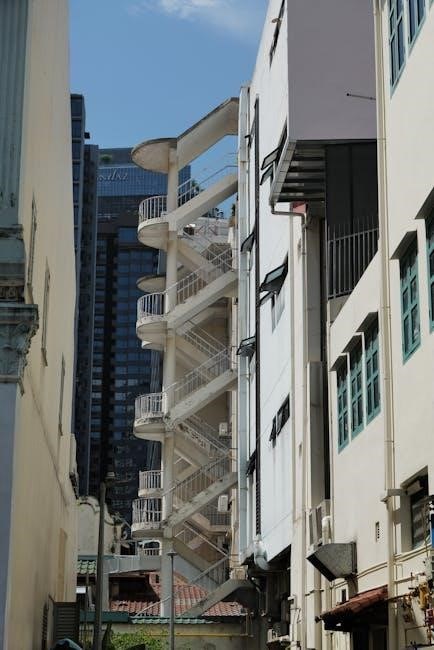
Seasonal Maintenance
Seasonal pool care ensures your pool remains pristine through opening, closing, and winterizing․ Proper preparation prevents damage and maintains water quality year-round․ Regular seasonal tasks are crucial․
Opening the Pool for the Season
Opening your pool for the season involves several key steps to ensure it’s clean and safe․ Start by removing the cover and inspecting for damage․ Clean the pool floor and walls thoroughly, and reassemble equipment like pumps and filters․ Test the water chemistry, adjusting pH, chlorine, and alkalinity levels as needed․ Shock the pool to eliminate contaminants and allow it to circulate before use․ Proper opening ensures a healthy and enjoyable swimming environment throughout the season․ Regular maintenance during this phase prevents future issues․
Closing the Pool for the Season
Closing your pool for the season requires careful preparation to protect it from damage․ Start by balancing the water chemistry, ensuring pH, alkalinity, and chlorine levels are stable․ Clean the pool thoroughly, removing debris and vacuuming the floor․ Drain the equipment, including pumps and heaters, to prevent freezing․ Use a winterizing kit to protect plumbing lines․ Cover the pool securely to keep out dirt and pests․ Test and adjust stabilizer levels to safeguard the pool during the off-season․ Proper closing ensures your pool remains in great condition for the next year․
Winterizing your pool is crucial to prevent damage from freezing temperatures․ Begin by lowering the water level below the skimmer and return jets․ Blow out all plumbing lines using a shop vac to remove excess water․ Add winterizing chemicals to prevent algae growth and stabilize the water․ Disconnect and drain the pump, filter, and heater, storing them in a dry place․ Install winter plugs in the return lines and cover the pool with a durable cover to protect it from debris and contamination during the cold months․ Regular checks ensure everything remains secure․
Identify and resolve pool problems promptly to maintain clarity and safety․ Common issues include algae growth, cloudy water, and equipment malfunctions․ Regular testing and maintenance help prevent these problems․ Algae growth can quickly turn your pool green and cloudy․ To remove algae effectively, start by brushing the walls and floor thoroughly to dislodge it․ Adjust the pH levels to between 7․2 and 7․6 to optimize chlorine effectiveness․ Use a shock treatment or algaecide as needed․ Ensure proper circulation and filtration to prevent regrowth․ Regular maintenance and chemical balance are key to keeping algae under control and maintaining clear, safe water․ Identifying and repairing leaks promptly is crucial to prevent water loss and structural damage․ Start by inspecting the pool and equipment for visible cracks or water seepage․ Check the pump, pipes, and fittings for loose connections; Use a sealant or replace damaged parts as needed․ For more severe leaks, consider hiring a professional with specialized tools to locate and repair the issue effectively․ Regular inspections can help catch leaks early, ensuring your pool remains safe and functional․ Cloudy pool water is often caused by imbalanced chemicals, poor filtration, or contamination․ Start by testing pH, chlorine, and alkalinity levels, adjusting as needed․ Shock the pool if organic contaminants are present․ Run the filter continuously to clarify the water․ If the issue persists, clean or replace the filter cartridges․ Introducing a water clarifier can help coagulate tiny particles for easier removal․ Regular maintenance and proper chemical balance are key to achieving and maintaining crystal-clear water․ Regular water testing ensures optimal pool conditions․ Use manual kits or digital devices to monitor pH, chlorine, and alkalinity levels, maintaining a safe and clean environment․ Manual testing kits are essential for monitoring pool water chemistry․ They typically include test strips or reagents to measure pH, chlorine, and alkalinity levels․ To use them, collect a water sample, add the appropriate reagents, and compare the color changes to the provided chart․ Accurate readings ensure balanced water, preventing issues like algae growth or equipment damage․ Regular testing with these kits helps maintain a safe and clear pool environment throughout the season․ Always follow the manufacturer’s instructions for precise results․ Digital testing devices offer advanced accuracy and convenience for monitoring pool water chemistry․ These devices can measure multiple parameters, including pH, chlorine, and alkalinity, with precise digital readings․ Many models provide instant results, eliminating the need for manual color matching․ Some devices connect to apps, allowing you to track water quality history and receive dosage recommendations․ While more expensive than manual kits, digital testers are faster and reduce the risk of human error․ Regular use ensures balanced water chemistry, preventing issues like algae growth or cloudy water․ Always follow the manufacturer’s instructions for optimal performance․ Ensure a safe pool environment by following essential precautions․ Regularly inspect equipment, secure chemicals, and supervise swimmers․ Prevent accidents with clear safety guidelines and emergency preparedness․ Maintaining a safe pool environment requires adherence to essential precautions․ Always turn off the pump before cleaning or servicing equipment to prevent accidents․ Keep the pool area clear of obstacles and ensure proper lighting․ Supervise children and inexperienced swimmers at all times․ Store chemicals in a secure, well-ventilated area and follow the manufacturer’s instructions for handling․ Regularly inspect pool fences, gates, and latches to ensure they are secure․ Post emergency contact information and have a first aid kit nearby․ These measures help prevent injuries and ensure a safe swimming experience․ Electrical safety is crucial for pool maintenance to prevent shocks and accidents․ Ensure all pool equipment, including pumps, heaters, and lighting, is installed and maintained by licensed professionals․ Keep electrical components at least 12 feet away from the pool to comply with safety standards․ Regularly inspect cords and connections for damage or wear․ Never operate electrical devices near water or while standing on wet surfaces․ Install Ground Fault Circuit Interrupters (GFCIs) to protect against electrical shocks․ Always follow manufacturer guidelines and local regulations for safe operation․ Being prepared for emergencies is vital for pool safety․ Keep a first aid kit and emergency contact numbers nearby․ Regularly inspect pool equipment and surroundings for potential hazards․ Ensure all family members and guests know basic lifesaving techniques․ Familiarize yourself with rescue equipment like pool floats or shepherd’s hooks․ Conduct occasional emergency drills to ensure everyone knows what to do in case of an accident․ Always have a phone accessible near the pool area to quickly call for help if needed․ Stay vigilant and proactive to prevent incidents and respond swiftly when they occur․ Consulting professionals ensures expert care and resolves complex issues efficiently․ They offer tailored solutions, from seasonal openings to advanced repairs, optimizing your pool’s performance and longevity․ Hiring a professional is essential when facing complex issues like persistent algae blooms, equipment malfunctions, or major repairs․ Professionals can also assist with seasonal tasks such as pool opening and closing, ensuring everything is done safely and efficiently․ If you lack the time or expertise to maintain your pool, relying on a qualified technician guarantees optimal results․ They provide tailored solutions and prevent costly future issues, ensuring your pool remains safe and enjoyable year-round․ When searching for reliable pool maintenance services, consider recommendations from trusted sources like friends or online reviews․ Ensure the company is licensed and experienced in handling various pool types and issues․ Check for certifications and ask about their range of services, from routine cleaning to complex repairs․ A reputable service will provide clear quotes and tailored solutions, ensuring your pool receives the care it needs to stay in optimal condition․ Hiring professionals ensures your pool is serviced with expertise and efficiency․ They handle complex tasks like chemical balancing and equipment repairs, saving you time and effort․ Regular maintenance by pros prevents costly issues, extends equipment lifespan, and enhances safety․ Their knowledge of best practices guarantees optimal water quality and a cleaner, healthier swimming environment․ Professional care also provides peace of mind, knowing your pool is always ready for enjoyment․ Explore detailed checklists, calculators, and guides for precise pool care․ These tools offer step-by-step solutions and expert advice to maintain your pool effectively and efficiently year-round․ A comprehensive pool maintenance checklist ensures no task is overlooked․ Daily tasks include skimming and monitoring equipment, while weekly tasks involve brushing walls and testing chemicals․ Monthly checks include deep cleaning and equipment inspections․ Seasonal tasks cover opening and closing procedures․ These checklists help maintain a safe, clean, and functional pool․ They also prevent costly repairs by catching issues early․ Use a checklist to stay organized and ensure your pool remains in optimal condition throughout the year․ Pool maintenance calculators simplify chemical dosing and balancing․ Tools like PoolMath help determine precise amounts of chlorine, CYA, and acid needed․ They ensure optimal water balance, preventing over- or under-treatment․ These calculators also guide seasonal adjustments and troubleshooting․ By inputting test results, you receive tailored recommendations․ They are invaluable for maintaining safe and clear water․ Regular use prevents chemical imbalances, safeguarding equipment and swimmers․ Utilize these tools to streamline your maintenance routine and achieve professional-grade pool care effortlessly․ Explore additional resources for advanced pool care․ Websites like TFP offer comprehensive guides on troubleshooting and chemical balance․ PoolMath is a trusted calculator for precise dosing․ Manuals from manufacturers provide specific equipment care instructions․ Seeking professional advice from certified technicians ensures personalized solutions․ These resources complement your knowledge, helping you address complex issues and optimize your pool’s condition․ Stay informed with the latest trends and expert tips to enhance your maintenance routine and enjoy a pristine pool year-round․Winterizing Your Pool
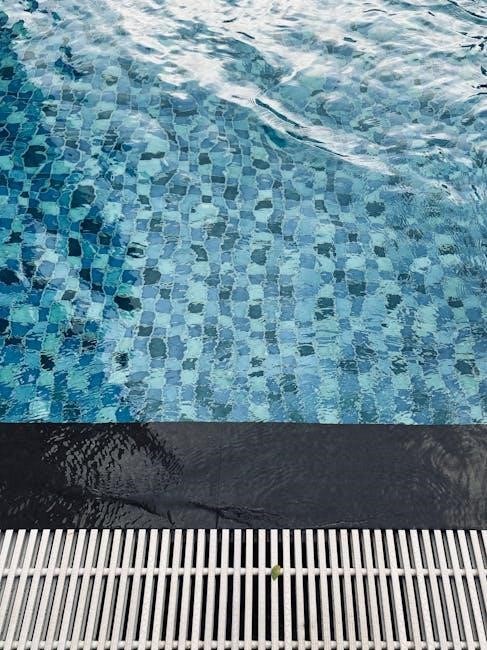
Troubleshooting Common Issues
Removing Algae
Fixing Leaks
Addressing Cloudy Water
Testing Pool Water
Using Manual Testing Kits
Digital Testing Devices
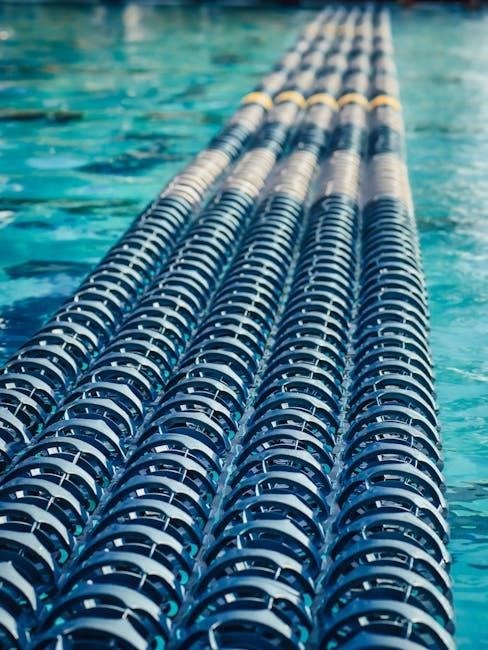
Safety Tips
General Safety Precautions
Electrical Safety
Emergency Preparedness

Professional Help
When to Hire a Professional
Finding Reliable Services
Benefits of Professional Maintenance

Additional Resources
Pool Maintenance Checklists
Pool Maintenance Calculators
Further Reading and Guides